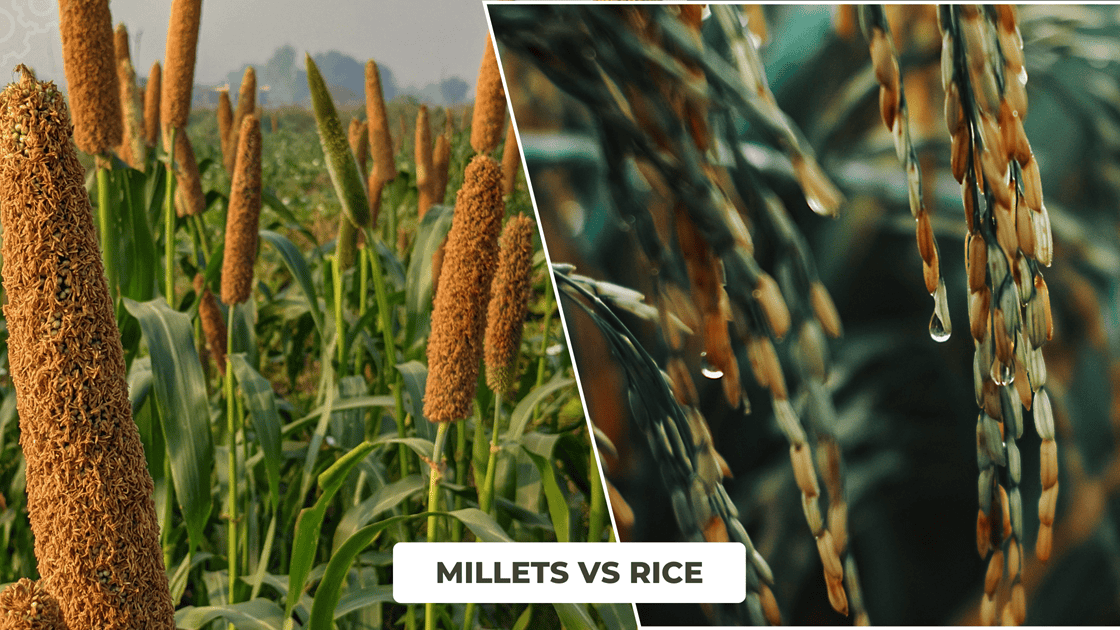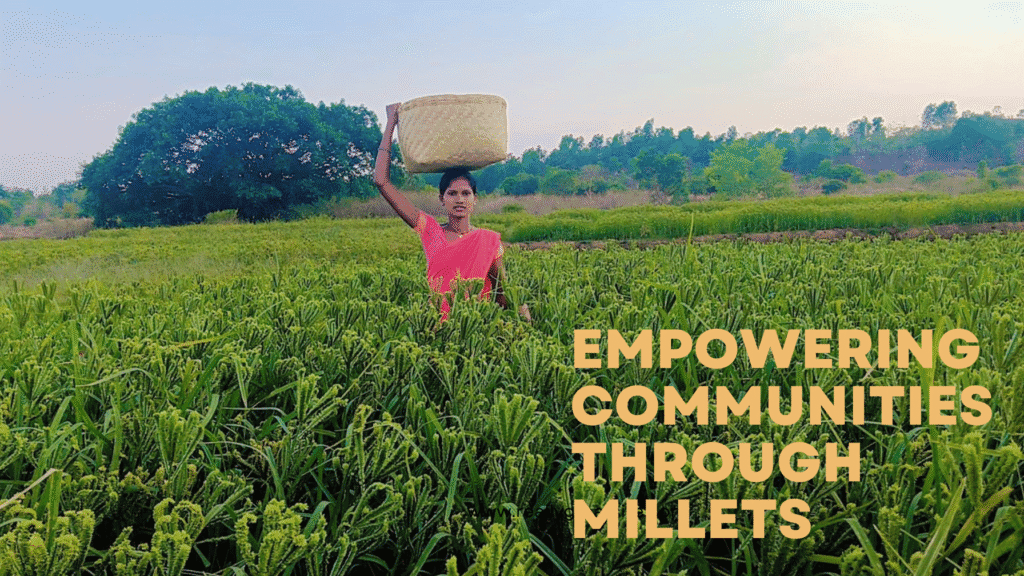Table of Contents
Millets vs Rice: A Grain Choice That Can Change the Planet
Every grain we choose to eat has a story. A story of the farmer who toils under the sun, of the water that nourishes the soil, and of the planet that sustains us. For decades, rice has been the hero of Indian kitchens, feeding millions and ensuring food security. But this hero has a darker side – it guzzles water, depletes groundwater, and contributes to greenhouse gas emissions, threatening the very sustainability of our food systems.
On the other hand, the humble millets—once considered the “poor man’s food”—are now being celebrated as the grains of the future. These ancient grains are nutritional powerhouses, climate-resilient, and farmer-friendly. The Government of India, through initiatives like the International Year of Millets (2023) and inclusion of millets in PDS and mid-day meals, is pushing for a millet revolution.
As a Certified Millet Advisor, I have seen first-hand how switching to millets can change lives—not only for our health but also for farmers and the planet. With a small effort from each of us, we can create a ripple effect that benefits millions.
So, should you switch from rice to millets?
Here’s the answer, backed by research, live examples, and a deep concern for our future.
Millets vs Rice – A Quick Comparison
| Parameter | Millets | Rice |
| Calories | ~350 kcal/100g (lower carbs, higher fiber) | ~365 kcal/100g (high carbs, low fiber) |
| Glycemic Index | Low (35-54) – Diabetes-friendly | High (70-89) – Blood sugar spikes |
| Protein | 7-12g/100g, rich in amino acids | ~6-7g/100g |
| Fiber | 3-10 times higher than rice | Very low fiber |
| Micro Nutrients | High in iron, calcium, zinc & B-vitamins | Lower micronutrient profile |
| Water Requirement | 1,500-2,500 L/kg grain | 3,000-5,000 L/kg grain |
| Environmental Impact | Low GHG emissions, drought-resilient | High GHG emissions, groundwater depletion |
7 Powerful Reasons to Switch to Millets Today
1. Millets Are Nutritional Powerhouses
Millets are not just grains; they are tiny packets of nutrition. Packed with protein, dietary fiber, iron, calcium, and antioxidants, millets are a superfood for today’s lifestyle diseases.
A policy brief by ICAR suggests that replacing rice with millets can increase protein intake by 5% and iron by 49%, significantly reducing anemia in women and children.
If you are diabetic, millets’ low glycemic index keeps your blood sugar stable.
If you are trying to lose weight, their high fiber keeps you full for longer, preventing overeating.
2. Millets Save Water – A Solution to India’s Water Crisis
Did you know? 91% of India’s freshwater is used in agriculture, and rice alone consumes 81% of the monsoon water used for cereal production.
On the other hand, millets thrive in dry regions with just a fraction of the water rice needs. Research from Uttar Pradesh shows that while rice needs up to 9,130 m³/ha, millets like jowar and bajra require just 3,565-3,781 m³/ha.

If even 25% of rice-growing areas shift to millets, we could save billions of liters of groundwater every year.
3. Millets Fight Climate Change
Rice is not just a water guzzler; it’s a methane emitter. Paddy fields are responsible for nearly 10% of India’s agricultural greenhouse gas emissions.
Switching to millets can reduce GHG emissions by 2% to 13% while improving climate resilience.
Millets grow naturally in semi-arid, drought-prone areas without heavy irrigation or chemical fertilizers, making them the true climate-smart grains.
4. Millets Are Better for Farmers’ Livelihoods
For farmers, millets are a blessing:
- Low input cost: Millets need little to no chemical fertilizers or pesticides.
- Climate resilience: Even in droughts, millets provide stable yields.
- Rising demand: With government support and growing global demand, farmers can earn better prices for millets than for rice.
- The Government of India has already introduced Minimum Support Prices (MSP) for millets and is encouraging millet processing and export.
5. Millets Can Replace Rice Without Compromising Calories
Some fear that switching from rice may reduce calorie intake. But research shows that millets can replace rice without compromising energy supply while improving protein (+1% to +5%) and iron (+5% to +49%) levels.
In simple words, you don’t lose calories, but you gain nutrition.
6. Millets Are the Answer to Diabetes & Obesity
Rice’s high glycemic index leads to rapid sugar spikes, a major reason for the rising cases of diabetes and obesity in India. Millets, on the other hand, release sugar slowly into the bloodstream, making them ideal for diabetics, weight watchers, and heart patients.
7. Millets Are the Future – Supported by Policy & Global Demand
The International Year of Millets 2023 put millets on the global stage. India is now exporting millet-based products to countries like Canada, the USA, and Australia. Millets are included in PDS and mid-day meal schemes, ensuring better nutrition for children. The MSP of millets is rising every year, encouraging farmers to grow more.
Punjab: A Groundwater Crisis & The Shift to Millets
Punjab, once known as the rice bowl of India, is now struggling with severe groundwater depletion. The Down to Earth report highlights that Punjab had to ban hybrid paddy seeds to save groundwater.
But there is hope.
Dilpreet Singh – A Millet Hero from Punjab
In Sangrur, Dilpreet Singh, a young farmer, gave up water-guzzling rice and switched to natural millet farming. Dilpreet utilizes natural farming techniques on his ancestral land, which spans approximately 15 acres. Today, he is not only helping conserve water but also exporting ready-to-eat millet products to health-conscious people of Australia and Canada. He has created his brand- ‘Healthy Soil, Food & People’.
Dilpreet’s story is a ray of hope—showing how farmers can earn better while saving the planet.
What You Can Do – Join the Millet Movement
Switching to millets is not just a diet choice; it’s a movement for change.
- Replace one rice-based meal a day with a millet-based dish.
- Support local millet farmers and brands.
- Spread awareness by sharing your millet stories online.
Conclusion: A Grain Revolution for a Better Tomorrow
“Millets are not just grains; they are a movement. A movement for better health, for farmers’ prosperity, and for saving our planet. As I always say – one small change in our kitchen can bring a big change in the fields. Together, let’s make this planet a better place for the next generation.”
Have you tried replacing rice with millets? What’s your favorite millet recipe? Share your feedback, suggestions, or stories in the comments. Let’s inspire each other and build a community of millet lovers.
I’d love to hear your thoughts!
Join me in the millet movement. Together, we can change the millet ecosystem in India.
Author: Tapas Chandra Roy, A Certified Farm Advisor on Millets, ‘Promoting Millets from Farm to Plate’, and an Author of the book -” Millet Business Ideas-Empowering Millet Startups”. In a mission to take the forgotten grains- Millets to Millions. To remain updated on my blogs on Millets, please subscribe to my newsletter, and for any queries, please feel free to write to tapas@milletadvisor.com


